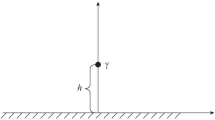It is found that the accelerated motion of a linear dielectric leads to its polarization. During the accelerated translational motion of a dielectric plate, the first surface in the acceleration direction becomes positively charged. For registration of polarization charges, the metal coatings were superimposed on the plate surfaces. The potential difference between the electrodes is proportional to the acceleration. At a constant acceleration, it increases with the increase in the dielectric surface area and dielectric constant and is almost independent of the thickness of the dielectric.
Similar content being viewed by others
References
R. C. Tolman and T. D. Stewart, Phys. Rev., 8, No. 2, 97–116 (1916).
I. M. Tsidil’kovskii, Sorosovskii Obrazovat. Zh., 6, No. 9, 87–94 (2000).
I. E. Tamm, Fundamentals of the Theory of Electricity [in Russian], GITTL, Moscow , 1956.
А. G. Zavodovskii, A Device for Measuring the Acceleration of the Motion of an Object, Russian PM Patent No. 92965, BI No. 10, 10.04. 2010.
Author information
Authors and Affiliations
Corresponding author
Additional information
Translated from Izvestiya Vysshikh Uchebnykh Zavedenii, Fizika, No. 9, pp. 50–53, September, 2012.
Rights and permissions
About this article
Cite this article
Zavodovskii, А.G. Inertial dielectric polarization. Russ Phys J 55, 1034–1038 (2013). https://doi.org/10.1007/s11182-013-9918-6
Received:
Revised:
Published:
Issue Date:
DOI: https://doi.org/10.1007/s11182-013-9918-6




